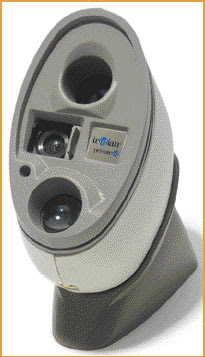Brent D. Johnson, Senior News Editor
Maintaining your identity in this age of digital encryption and optical counterfeiting is a problem that demands increasing technical sophistication. Signatures, passwords and fingerprints simply do not provide adequately inexpensive, fast and efficient means to determine identity for everyday transactions.

Optical and mechanical designers used microlenses to help shrink an iris-imaging system from a 2 x 2-ft apparatus to a device the size of a softball.
The Authenticam from Iridian Technologies Inc. is an iris-imaging system that uses wavelet analysis to form an Iriscode for security measures.
Michael Braithwaite, Iridian's program manager, said iris authentication is more accurate than retina scanning and DNA testing because the iris undergoes a random rippling process during its formation, yielding a very detailed structure. The chance that one iris is identical to another is 1 in 1072, he said. To put this in some perspective, only 1011 people have ever lived.
These odds have attracted interest from the US government and many financial companies for authentication, door entry and account access security, but the largest potential application is built-in identification systems for personal computers.
The original Authenticam design, however, didn't fit the computer market's needs. Braithwaite faced a design challenge: shrinking the prototype from a 2 x 2-ft apparatus laid out on an optical bench to a device the size of a softball.
Braithwaite said he chose Edmund Industrial Optics to help redesign the device because of its long history of optics development, its engineering capability and its ability to provide off-the-shelf solutions. These elements convinced him that the company could deliver the speed to market.
Jeremy Govier, senior applications engineer for Edmund Industrial Optics, said previous iris-authentication designs have had many components with mirrors on motor-controlled gimbals. "The motorization had to go," Govier said. Instead of having the camera find the eye, the user positions himself or herself in front of the camera.
Engineers also had to shrink the optics package from a six-element lens. As a first step, they tested the optical design and determined that the lenses had been "overengineered." They discovered that the software would produce adequate results from a lens with reduced resolution.
The second-generation Authenticam system, powered by Iridian's PrivateID software, is in production. Its top aperture uses a 25-mm-diameter, narrow-field-of-view lens dedicated to imaging the iris. A middle aperture has a microlens for color, wide-field-of-view video. The bottom aperture has an 18-mm-diameter lens that focuses the illuminator when it blinks to image the iris. A very small fourth aperture houses a green light-emitting diode that illuminates when the power is on. And the entire device, including its base, is 5 1/2 in. high, 3 1/2 in. deep and 2 1/4 in. wide and weighs in at about 1/2 lb.